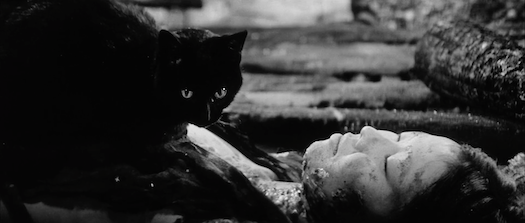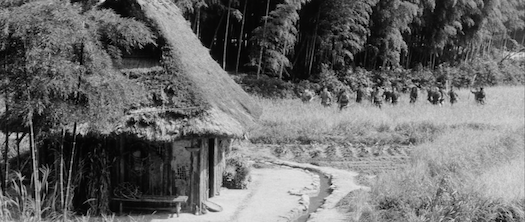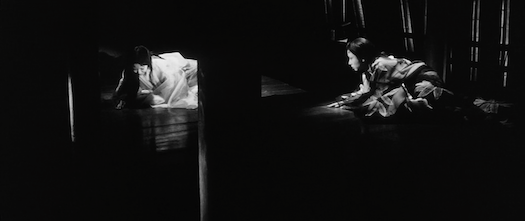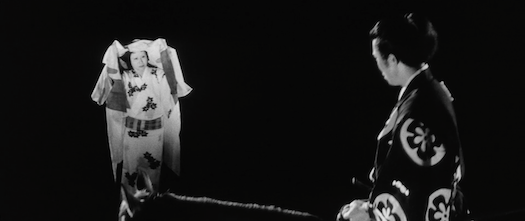A Haunting in October: "Kuroneko"
 Monday, October 16, 2023 at 1:00PM
Monday, October 16, 2023 at 1:00PM by Nick Taylor

Cats! We love ‘em. I know I do. Are we all cat people? No, but variety is the spice of life. Spirits of wronged women avenging their own deaths? Well loved across all kinds of cultural traditions and generic conventions. Putting cats and wronged women together, then, should be an instant recipe for success, yes? Especially if the title in question is as lauded as Kaneto Shindo’s 1968 film Kuroneko?
Set roughly one millenia before it was filmed, Kuroneko follows two women, mother Yone (Nobuko Otawa) and her daughter-in-law Shige (Kiwako Taichi), who live together in a bamboo cottage on the outskirts of a peasant village...

One day Yone and Shige’s home is met by a troop of samurai, who pillage their supplies and rape them before burning their house down with them in it. Burnt and bloody in the rubble, their corpses are tended to by a mysterious black cat who licks at their faces, over two decades before the cat-based resurrection of Batman Returns. The women return to the land of the living as ghosts, dressed in the clothing and makeup of upper-class ladies, with a routine. They want revenge on all samurai. Shige wanders the forests of Rajomon at night, finding lone samurai to escort her to her mother in their spectral mansion, where they ply the men with sake and rip the fucker’s throats out while the black cat watches. Morning comes, and the samurai lies dead and bloody in the rubble of the women’s desecrated bamboo home.
This passage, which comprises roughly the first thirty minutes of Kuroneko, is exceptional. You could practically take it as its own film, as the women amass an impressive body count on a coterie of unpleasant, leering men who may be but likely aren’t the same men who brutalized and murdered them. I had expected a more direct, Kill Bill style reckoning, but the relative anonymity of the samurai even in close-up during the prologue prevents this reading. Shige and Yone’s actions are institutional and indiscriminate, slaughtering these men who wield their power with impunity and avenging their own deaths a hundred fold. Sure, their powers come from a pact made directly with the underworld, but we love vengeance, and surely their goal to kill every samurai in existence can’t possibly hold any consequences.

Shindo cloaks all of this within an otherworldly atmosphere. Kiyomi Kuroda’s black-and-white cinematography and Hisao Enoki’s editing are instrumental to achieving this mood, pulling out textures and colors while superimposing shots and images together. The camera placement relishes in odd framing choices and insinuating movements, heightening the folkloric majesty of the women’s actions while conjuring devilishly indelible tableaus of violence and satisfaction. I love the recurring image of Shige escorting some doomed samurai through the woods, where the men bleed into the shadows of the trees and the night while the fabric of her costumes and the glow of her skin stand out gloriously. She looks more real than these insubstantial brutes ever could. The sound mix and music add their own layers of ethereal menace and percussive action, giving the Rajomon forests their own spooky resonance.
What does cost the film is its reorientation around Gintoki (Kichiemon Nakamura), a newly-promoted samurai who is soon revealed to be the son/husband of the two ghosts. Prior to this, Shindo did not position Yone or Shige as point of view characters throughout their exploits, keeping them at a distance that’s equally impressed and terrified by them without conscripting them into heroic or villainous lights. Gintoki quickly becomes the central figure through which we experience Kuroneko, and it’s just not as interesting once his greener soul becomes our guide. This is the kind of film where achieving a singular atmosphere is higher on the director’s list of concerns than story or character, so maybe complaining about narrative is being churlish, and it’s not as if Kuroneko’s technical ingenuity suddenly stalls around him.

All these caveats, but even so, Kuroneko’s just a better film when we’re watching the women lure men to their deaths and jumping through the air rather than watching some guy struggle with duty and family. All this so he can learn samurai can be as evil as any ghost, something the audience has known the whole time. More than that, the glimpses we get of Shige and Yone wrestling with their own sense of duty and family are just more involving to me. Especially as it becomes less clear if the women are able to retain any sense of their original selves or are fully transforming into demons, their choices carry stakes that feel more unique to this story and more worthwhile to observe. Kuroneko never stops being a cinematically inventive haunting, and the final half hour does recuperate the film somewhere close to the glories of its first third. But it’s best as a ghost story in the beginning and I’m just not as enchanted with the object it chooses to be for its remaining runtime. \
Also, the cat should have been in way more of the film.
 1968,
1968,  Happy Halloween,
Happy Halloween,  Horror,
Horror,  Kuroneko
Kuroneko 


Reader Comments (2)
It's been a long time since I've seen the film but I do remember getting scared at what I saw.
I have never seen this, but the two Shindos I got to see are A M A Z I N G: Onibaba and The Naked Island, and I am NOT a horror person.